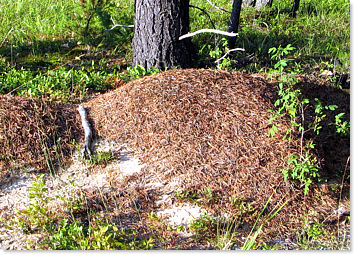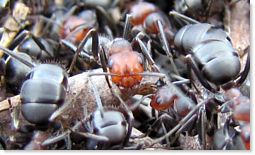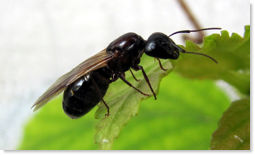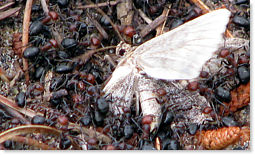
Swarming Thatching Ants!
| By Doug Collicutt | (Click thumbnail images for more pictures.) |
What's black and red, forms writhing swarms, are interesting to watch, but bite like heck if you watch too long? Actually, the more I think about it, that could mean a variety of my favourite critters, but in this case I mean Thatching Ants!
 A Thatching Ant nest mound.
A Thatching Ant nest mound.Anyone who's walked through the Jack Pine forests of Manitoba has seen them, the large, often grave-sized mounds of pine needles and other forest debris, that, on a sunny day, are swarming with ants. These are the homes of Thatching Ants. In bad weather these appear to be lifeless piles of debris, but on sunny days they can be boiling with activity, as you'll see in the video below. At my cottage in Whiteshell Provincial Park, Thatching Ant colonies are abundant, especially in Jack Pine forests wherever there is a site that receives good sunshine. The edges of roads and snowmobile trails are great spots to find them. Warmth from the sun is an important resource for the developing eggs and larvae.
If you watch an active colony closely for any length of time you will witness the ants bringing in, not only more building materials, but food, in the form of caterpillars, and various other insects or parts thereof. It's not uncommon to see several ants struggling with some still-alive prey item being dragged to its doom down the tunnels that lead below ground.
Whenever you're watching these large red and black ants, be careful, they bite! After all, if you are a large mammal standing near their nest, then you are up to no good and must be seen off! Trust me, if you do evoke the wrath of an entire colony of Thatching Ants, you won't hang around for long. However, if you're careful and don't get too close, you can be treated to some amazing animal behaviour. If you have a camera you don't mind setting on the ground, you can get some amazing video, too, as you'll see below.
With the video capabilities of just about every camera or phone out there these days, it's no wonder that the internet is getting clogged with videos of EVERY aspect of EVERYTHING that goes on in our modern world. I happen to think that the cool critter videos I've been launching on NatureNorth (You can go to NatureNorth's YouTube Channel directly, too.) don't fit into the clogging category though. And I hope you'll agree when you watch "Swarming Ants" below, but I hope you'll read a little bit about Thatching Ants first, they're cool critters.
A Little Biology of Thatching Ants
I really just wanted to show off some cool ant videos, but I figured I should make an effort to do a little more than just slap up another YouTube video, so here's a quickie version of the biology of Thatching Ants. Hopefully, I'll get the time to beef this up later, though it's actually kind of hard to find much info on these critters. Like so many prominent species and aspects of Manitoba's ecosystems they're not that well studied here or elsewhere.
Description
Thatching Ants, of the Genus, Formica, are large ants (for ants), about 4-8 mm in length. They are stocky ants (again, for ants) with large heads and powerful jaws. Most are bi-coloured, red and black, but some species are all black. It's usually the head end that is red. They are polymorphic; that is, within one colony there may be workers of different size and shape.
The large mound created by the ants is more often noticed than the ants themselves. Thatching Ant mounds may be 1 or 2 meters across and half a meter high! The mound really only represents part of the entire nest structure. Much of the colony's home is a vast array of subterranean tunnels.
Name
Thatching Ants derive their common name from their habit of creating large mounds which appear to be "thatched" as they have materials layered on top like a traditional European thatched roof. The scientific name of the Genus: Formica, derives from Latin and means, literally, "ant". (I didn't find out which of the many species I'd encountered so I can't expound of the species name at this point. See update below.)
Update: From an email I received from James Trager, Ph. D.; Myrmecologist / Naturalist Shaw Nature Reserve, Gray Summit Missouri - "As for the species of thatching ants in your pictures, as far as I can tell without specimens for examination, you have Formica integroides." Thanks, James!
Formic acid obtained its name as it was first distilled from ants. Ants produce and exude formic acid as an anti-predator mechanism. Even a bear will quit digging up a nest after its had enough formic acid sprayed up its nose. (The flooring and counter-top material called "Formica" is a compound manufactured from "mica" and by chance ended up with the same name, but there is no relation.)
Classification
The formal classification of Thatching Ants goes like this, again only to Genus level:
| Kingdom: | Animalia |
| Phylum: | Arthropoda |
| Class: | Insecta |
| Order: | Hymenoptera |
| Family: | Formicidae |
| Subfamily: | Formicinae |
| Tribe: | Formicini |
| Genus: | Formica |
Life Cycle
A Thatching Ant colony is initiated by one mated queen. She finds a suitable location, digs some tunnels and lays eggs, then rears the first batch of young to maturity. These workers, all females, then begin to care for the queen as she focuses on egg-laying. And they take over the nest building and hauling food back for the colony. Colonies may persist for up to 20 years and can contain many thousands of individuals. In late summer Thatching Ant colonies produce their reproductive forms, the winged males and females (remember "flying ants"?). The females (new queens) and males (drones) fly away from the colony. They mate and shortly afterward the males will die, their role in the life cycle completed. The inseminated queens build new nests and start new colonies. (The ant pictured here is actually a Carpenter Ant (Camponotus novaeboracensis), that was mis-identified. Still cool ant pictures though. Thanks again to Dr. Trager for the ID.)
|
Some colonies in some species may be polygynous (have more than one queen) and some colonies may have more than one main nest (be polydomous).
Role in Nature
While I normally hate to assign a "role" or "value" to any species in nature, sometimes it helps to tell people how valuable certain species can be, especially if it's a critter that people often malign or get bitten by. Ants, in general, get a bad rap for invading our homes and ruining picnics, but they are some of the most beneficial insects. They catch and eat huge quantities of other insect pests. They also scavenge, feeding on the remains of larger dead animals, helping to clean up the planet. Their burrowing, for nest construction, helps aerate soils and promotes water absorption into the landscape. Ants are one of the most important soil-building animals.
Ants, in turn, are food for many other critters, including in some case very large critters, like bears. If you've ever walked in the woods and seen ant mounds with great holes in the middle, or the whole mound ripped apart, that's bear damage. Bears love the eggs and larvae that a large colony can produce. The ants move their eggs and larvae up into the raised warmer sections of their nest to speed development, which puts them at risk from marauding bears. (More than just pic-a-nic baskets are at risk from hungry bruins.)
In winter the ants in a colony go down deeper into the below-ground tunnels of the nest and remain below the frost-line until spring. Several species of small snakes and the young of larger snakes are known to use ant nests as over-wintering refuges, too. How they manage to co-exist with the ants all winter is not known.
Manitoba Ants
I wasn't able to identify the species of Thatching Ants that I encounter near my Whiteshell cottage. Hopefully someone will prepare a good field guide to ants one day. A 1989 article in the Proceedings of the Entomological Society of Manitoba lists 52 different species of ants in Manitoba. Check it out for yourself: List of the Ants of Manitoba.
Final Thoughts
I've been chomped enough times by angry Thatching Ants that they now have my complete respect. I usually keep my distance from them, but on a couple of occasions now I've been unable to resist dropping my camera down onto an active nest. The video I've posted here is the result. Now, enjoy, I hope, "Swarming Ants".
|
Some Extra Ant Stuff:
Not long after I first posted this article another ant-related opportunity arose, and it happened to involve another species of Thatching Ant, but this time, one that lived in my backyard in the city. My wife and I were having a drink in our yard one evening, it was mid-June. I happened to turn around and noticed a hoard of ants streaming out from under an old railroad tie we have as edging for our garden. It was an emerging swarm of flying ants, the winged "breeders" of the large colony of ants that were, unbeknownst to me, living in my yard. I initially thought they were another species of Thatching Ant (Formica sp.), but not one that builds above-ground mounds, but I've since learned they were Carpenter Ants (Camponotus novaeboracensis). The winged ants emerged, milled around and, after a few minutes, flew off rather clumsily. We saw some Sparrows grab a few from the ground and some were taken on the wing. But it seemed that a large part of the rest of the ant colony, the wingless workers, emerged and ran around rather frantically, too. It was quite the sight, and for once I had my camera close by so I grabbed some video. It was a good thing I had the camera handy, as within 15 minutes the event was over, the winged ants were gone and the rest of the colony dissappeared back down underground. It was another lesson in: keep your eyes open, nature is always around you, even in your back yard.
I hope you enjoy " Flying Ant Swarm":
Thanks for learning about Thatching Ants! Bye for now!
If you liked this NatureNorth.com article, check out these other Bug Features:
The Dragonflies of Manitoba | Marvelous Migrating Monarchs
The Giant Water Bug | Mourning Cloaks - Butterflies in Snow
| You can help NatureNorth produce more great articles with a secure donation through PayPal. Our Google Adsense ads pay our server costs, but that's about it. To learn more follow this link: Support NatureNorth. Thank-you! | |
Return to: Summer Issue | NatureNorth Front page



